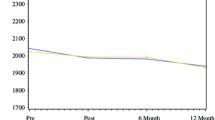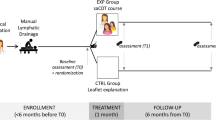Abstract
Purpose
To profile the prescription for and adherence to breast cancer-related lymphedema (BCRL) self-care modalities among breast cancer (BrCa) survivors with BCRL in a 12-month randomized weightlifting trial.
Methods
We developed a questionnaire that assessed prescription for and adherence to 10 BCRL self-care modalities that included physical therapy exercise, pneumatic compression pump, medication, lymphedema bandaging, arm elevation, self-administered lymphatic drainage, therapist-administered lymphatic drainage, compression garments, skin care, and taping. We measured prescription for and adherence to BCRL self-care modalities at baseline, 3, 6, and 12 months. Longitudinal logistic regression was used to estimate the odds ratio (OR) and 95 % confidence interval (95 % CI) associated with prescription for and adherence to BCRL modalities over time.
Results
This study included 141 BrCa survivors with BCRL. Women were prescribed an average of 3.6 ± 2.1 BCRL self-care modalities during the study. The prescription for therapist-administered lymphatic drainage (OR = 0.92, 95 % CI 0.88–0.96), pneumatic compression pump use (OR = 0.94, 95 % CI 0.89–0.98), and bandaging (OR = 0.96, 95 % CI 0.93–0.99) decreased over 12 months of follow-up. No other prescribed BCRL self-care modalities changed during the study. Over 12 months, the average adherence to all BCRL self-care modalities varied with 13, 24, 32, and 31 % of women reporting <25, 25–49, 50–74, and ≥75 % adherence, respectively. Over 12 months, there was a noticeable change from high to low adherence in self-administered lymphatic drainage, such that there was a 15 % increased likelihood of adherence <25 % compared to ≥75 % (OR = 1.15 (95 % CI 1.05–1.26); p = 0.002). The adherence patterns of all other modalities did not change over follow-up.
Conclusions
Our findings suggest the prescription for BCRL self-care modalities is variable. The average adherence to BCRL self-care was non-optimal. Future research is necessary to prepare BrCa survivors with the knowledge, skills, abilities, and resources necessary to care for this lifelong condition.
Similar content being viewed by others
References
Siegel R, Desantis C, Virgo K, Stein K, Mariotto A, Smith T, Cooper D, Gansler T, Lerro C, Fedewa S, Lin C, Leach C, Cannady RS, Cho H, Scoppa S, Hachey M, Kirch R, Jemal A, Ward E (2012) Cancer treatment and survivorship statistics, 2012. CA Cancer J Clin 62:220–241
Jemal A, Bray F, Center MM, Ferlay J, Ward E, Forman D (2011) Global cancer statistics. CA Cancer J Clin 61(2):69–90
Armer JM (2005) The problem of post-breast cancer lymphedema: impact and measurement issues. Cancer Invest 23:76–83
Norman SA, Localio AR, Potashnik SL, Simoes Torpey HA, Kallan MJ, Weber AL, Miller LT, Demichele A, Solin LJ (2009) Lymphedema in breast cancer survivors: incidence, degree, time course, treatment, and symptoms. J Clin Oncol 27:390–397
Francis WP, Abghari P, Du W, Rymal C, Suna M, Kosir MA (2006) Improving surgical outcomes: standardizing the reporting of incidence and severity of acute lymphedema after sentinel lymph node biopsy and axillary lymph node dissection. Am J Surg 192:636–639
Schrenk P, Rieger R, Shamiyeh A, Wayand W (2000) Morbidity following sentinel lymph node biopsy versus axillary lymph node dissection for patients with breast carcinoma. Cancer 88:608–614
Wilke LG et al (2006) Surgical complications associated with sentinel lymph node biopsy: results from a prospective international cooperative group trial. Ann Surg Oncol 13:491–500
Petrek JA, Heelan MC (1998) Incidence of breast carcinoma-related lymphedema. Cancer 83(suppl):2776–2781
Shih YC, Xu Y, Cormier JN, Giordano S, Ridner SH, Buchholz TA, Perkins GH, Elting LS (2009) Incidence, treatment costs, and complications of lymphedema after breast cancer among women of working age: a 2-year follow-up study. J Clin Oncol 27:2007–2014
Maunsell E, Brisson J, Deschenes L (1989) Psychological distress after initial treatment for breast cancer: a comparison of partial and total mastectomy. J Clin Epidemiol 42:765–771
Passik SD, McDonald MV (1998) Psychosocial aspects of upper extremity lymphedema in women treated for breast carcinoma. Cancer 83(suppl):2817–2820
Sneeuw KC, Aaronson NK, Yarnold JR, Broderick M, Regan J, Ross G, Goddard A (1992) Cosmetic and functional outcomes of breast conserving treatment for early stage breast cancer. 2. Relationship with psychosocial functioning. Radiother Oncol 25:160–166
Carter J, Raviv L, Appollo K, Baser RE, Iasonos A, Barakat RR (2010) A pilot study using the gynecologic cancer Lymphedema questionnaire (GCLQ) as a clinical care tool to identify lower extremity Lymphedema in gynecologic cancer survivors. Gynecol Oncol 117:317–323
Ahmed RL, Prizment A, Lazovich D, Schmitz KH, Folsom AR (2008) Lymphedema and quality of life in breast cancer survivors: the Iowa Women’s health study. J Clin Oncol 26:5689–5696
McWayne J, Heiney SP (2005) Psychologic and social sequelae of secondary lymphedema: a review. Cancer 104:457–466
Ahmed RL, Schmitz KH, Prizment AE, Folsom AR (2011) Risk factors for lymphedema in breast cancer survivors, the Iowa Women’s health study. Breast Cancer Res Treat 130:981–991
Kwan ML, Darbinian J, Schmitz KH, Citron R, Partee P, Kutner SE, Kushi LH (2010) Risk factors for lymphedema in a prospective breast cancer survivorship study: the pathways study. Arch Surg 145:1055–1063
Meeske KA, Sullivan-Halley J, Smith AW, McTiernan A, Baumgartner KB, Harlan LC, Bernstein L (2009) Risk factors for arm lymphedema following breast cancer diagnosis in black women and white women. Breast Cancer Res Treat 113:383–391
Tsai RJ, Dennis LK, Lynch CF, Snetselaar LG, Zamba GK, Scott-Conner C (2009) The risk of developing arm lymphedema among breast cancer survivors: a meta-analysis of treatment factors. Ann Surg Oncol 16:1959–1972
Harris SR, Hugi MR, Olivotto IA, Levine M, Steering Committee for Clinical Practice Guidelines for the Care and Treatment of Breast Cancer (2001) Clinical practice guidelines for the care and treatment of breast cancer: 11. Lymphedema CMAJ 164:191–199
Mayrovitz HN (2009) The standard of care for lymphedema: current concepts and physiological considerations. Lymphat Res Biol 7:101–108
Petrek JA, Pressman PI, Smith RA (2000) Lymphedema: current issues in research and management. CA Cancer J Clin 50:292–307
Moseley AL, Carati CJ, Piller NB (2007) A systematic review of common conservative therapies for arm lymphoedema secondary to breast cancer treatment. Ann Oncol 18:639–646
Ridner SH, Murphy B, Deng J, Kidd N, Galford E, Bonner C, Bond SM, Dietrich MS (2012) A randomized clinical trial comparing advanced pneumatic truncal, chest, and arm treatment to arm treatment only in self-care of arm lymphedema. Breast Cancer Res Treat 131:147–158
Ridner SH, Fu MR, Wanchai A, Stewart BR, Armer JM, Cormier JN (2012) Self-management of lymphedema: a systematic review of the literature from 2004 to 2011. Nurs Res 61:291–299
Korpan MI, Crevenna R, Fialka-Moser V (2011) Lymphedema: a therapeutic approach in the treatment and rehabilitation of cancer patients. Am J Phys Med Rehabil 90:S69–S75
Lee YM, Mak SS, Tse SM, Chan SJ (2001) Lymphoedema care of breast cancer patients in a breast care clinic: a survey of knowledge and health practice. Support Care Cancer 9:634–641
Vignes S, Porcher R, Arrault M, Dupuy A (2011) Factors influencing breast cancer-related lymphedema volume after intensive decongestive physiotherapy. Support Care Cancer 19:935–940
Schmitz KH, Troxel AB, Cheville A, Grant LL, Bryan CJ, Gross CR, Lytle LA, Ahmed RL (2009) Physical activity and Lymphedema (the PAL trial): assessing the safety of progressive strength training in breast cancer survivors. Contemp Clin Trials 30:233–245
Schmitz KH, Ahmed RL, Troxel A, Cheville A, Smith R, Lewis-Grant L, Bryan CJ, Williams-Smith CT, Greene QP (2009) Weight lifting in women with breast-cancer-related lymphedema. N Engl J Med 361:664–673
Schmitz KH, Ahmed RL, Troxel AB, Cheville A, Lewis-Grant L, Smith R, Bryan CJ, Williams-Smith CT, Chittams J (2010) Weight lifting for women at risk for breast cancer-related lymphedema: a randomized trial. JAMA 304:2699–2705
Brown JC, Troxel AB, Schmitz KH (2012) Safety of weightlifting among women with or at risk for breast cancer-related lymphedema: musculoskeletal injuries and health care use in a weightlifting rehabilitation trial. Oncologist 17:1120–1128
Aickin M, Gensler H (1996) Adjusting for multiple testing when reporting research results: the Bonferroni vs Holm methods. Am J Public Health 86:726–728
Ridner SH, Dietrich MS, Kidd N (2011) Breast cancer treatment-related lymphedema self-care: education, practices, symptoms, and quality of life. Support Care Cancer 19:631–637
Vignes S, Porcher R, Arrault M, Dupuy A (2007) Long-term management of breast cancer-related lymphedema after intensive decongestive physiotherapy. Breast Cancer Res Treat 101:285–290
Sherman KA, Koelmeyer L (2011) The role of information sources and objective risk status on lymphedema risk-minimization behaviors in women recently diagnosed with breast cancer. Oncol Nurs Forum 38:E27–E36
Sherman KA, Koelmeyer L (2012) Psychosocial predictors of adherence to lymphedema risk minimization guidelines among women with breast cancer. Psychooncology 22(5):1120–1126. doi:10.1002/pon.3111
Turner J, Hayes S, Reul-Hirche H (2004) Improving the physical status and quality of life of women treated for breast cancer: a pilot study of a structured exercise intervention. J Surg Oncol 86:141–146
Sandel SL, Judge JO, Landry N, Faria L, Ouellette R, Majczak M (2005) Dance and movement program improves quality-of-life measures in breast cancer survivors. Cancer Nurs 28:301–309
Cheville AL (2007) Current and future trends in lymphedema management: implications for women’s health. Phys Med Rehabil Clin N Am 18:539–553
Rourke LL, Hunt KK, Cormier JN (2010) Breast cancer and lymphedema: a current overview for the healthcare provider. Womens Health (Lond Engl) 6:399–406
Lawenda BD, Mondry TE, Johnstone PA (2009) Lymphedema: a primer on the identification and management of a chronic condition in oncologic treatment. CA Cancer J Clin 59:8–24
Funnell MM, Brown TL, Childs BP, Haas LB, Hosey GM, Jensen B, Maryniuk M, Peyrot M, Piette JD, Reader D, Siminerio LM, Weinger K, Weiss MA (2009) National standards for diabetes self-management education. Diabetes Care 32(Suppl 1):S87–S94
Stout NL, Binkley JM, Schmitz KH, Andrews K, Hayes SC, Campbell KL, McNeely ML, Soballe PW, Berger AM, Cheville AL, Fabian C, Gerber LH, Harris SR, Johansson K, Pusic AL, Prosnitz RG, Smith RA (2012) A prospective surveillance model for rehabilitation for women with breast cancer. Cancer 118:2191–2200
Curran GM, Bauer M, Mittman B, Pyne JM, Stetler C (2012) Effectiveness-implementation hybrid designs: combining elements of clinical effectiveness and implementation research to enhance public health impact. Med Care 50:217–226
Funding
This study was funded by a National Cancer Institute Grant (R01-CA106851) to KH Schmitz. BSN medical provided custom-fitted compression garments to all study participants. Neither the National Cancer Institute nor BSN medical had any role in study design, data collection and analysis, decision to publish, or preparation of the manuscript.
Conflict of interest
All authors declare no conflicts of interest. The authors have full control of all the primary data and agree to allow the editors of this journal access if requested.
Author information
Authors and Affiliations
Corresponding author
Rights and permissions
About this article
Cite this article
Brown, J.C., Cheville, A.L., Tchou, J.C. et al. Prescription and adherence to lymphedema self-care modalities among women with breast cancer-related lymphedema. Support Care Cancer 22, 135–143 (2014). https://doi.org/10.1007/s00520-013-1962-9
Received:
Accepted:
Published:
Issue Date:
DOI: https://doi.org/10.1007/s00520-013-1962-9




